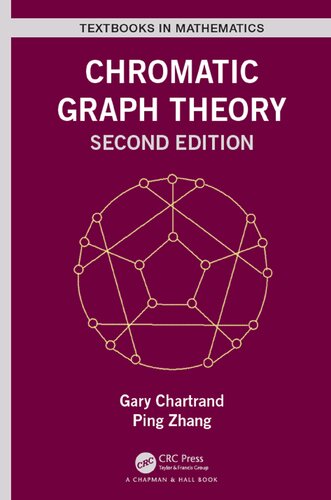

Most ebook files are in PDF format, so you can easily read them using various software such as Foxit Reader or directly on the Google Chrome browser.
Some ebook files are released by publishers in other formats such as .awz, .mobi, .epub, .fb2, etc. You may need to install specific software to read these formats on mobile/PC, such as Calibre.
Please read the tutorial at this link. https://ebooknice.com/page/post?id=faq
We offer FREE conversion to the popular formats you request; however, this may take some time. Therefore, right after payment, please email us, and we will try to provide the service as quickly as possible.
For some exceptional file formats or broken links (if any), please refrain from opening any disputes. Instead, email us first, and we will try to assist within a maximum of 6 hours.
EbookNice Team

Status:
Available0.0
0 reviews
ISBN-10 : 1138343862
ISBN-13 : 9781138343863
Author: Gary Chartrand, Ping Zhang
With Chromatic Graph Theory, Second Edition, the authors present various fundamentals of graph theory that lie outside of graph colorings, including basic terminology and results, trees and connectivity, Eulerian and Hamiltonian graphs, matchings and factorizations, and graph embeddings. Readers will see that the authors accomplished the primary goal of this textbook, which is to introduce graph theory with a coloring theme and to look at graph colorings in various ways. The textbook also covers vertex colorings and bounds for the chromatic number, vertex colorings of graphs embedded on surfaces, and a variety of restricted vertex colorings. The authors also describe edge colorings, monochromatic and rainbow edge colorings, complete vertex colorings, several distinguishing vertex and edge colorings. Features of the Second Edition: The book can be used for a first course in graph theory as well as a graduate course The primary topic in the book is graph coloring The book begins with an introduction to graph theory so assumes no previous course The authors are the most widely-published team on graph theory Many new examples and exercises enhance the new edition
0. The Origin of Graph Colorings
1. Introduction to Graphs
1.1 Fundamental Terminology
1.2 Connected Graphs
1.3 Distance in Graphs
1.4 Isomorphic Graphs
1.5 Common Graphs and Graph Operations
1.6 Multigraphs and Digraphs
Exercises for Chapter 1
2. Trees and Connectivity
2.1 Cut-Vertices, Bridges, and Blocks
2.2 Trees
2.3 Connectivity and Edge-Connectivity
2.4 Menger’s Theorem
Exercises for Chapter 2
3. Eulerian and Hamiltonian Graphs
3.1 Eulerian Graphs
3.2 de Bruijn Digraphs
3.3 Hamiltonian Graphs
Exercises for Chapter 3
4. Matchings and Factorization
4.1 Matchings and Independence
4.2 Factorization and Decomposition
Exercises for Chapter 4
5. Graph Embeddings
5.1 Planar Graphs and the Euler Identity
5.2 Hamiltonian Planar Graphs
5.3 Planarity versus Nonplanarity
5.4 Outerplanar Graphs
5.5 Embedding Graphs on Surfaces
5.6 The Graph Minor Theorem
Exercises for Chapter 5
6. Introduction to Vertex Colorings
6.1 The Chromatic Number of a Graph
6.2 Applications of Colorings
6.3 Perfect Graphs
Exercises for Chapter 6
7. Bounds for the Chromatic Number
7.1 Color-Critical Graphs
7.2 Upper Bounds and Greedy Colorings
7.3 Upper Bounds and Oriented Graphs
7.4 The Chromatic Number of Cartesian Products
Exercises for Chapter 7
8. Coloring Graphs on Surfaces
8.1 The Four Color Problem
8.2 The Conjectures of Hajós and Hadwiger
8.3 Chromatic Polynomials
8.4 The Heawood Map-Coloring Problem
Exercises for Chapter 8
9. Restricted Vertex Colorings
9.1 Uniquely Colorable Graphs
9.2 List Colorings
9.3 Precoloring Extensions of Graphs
Exercises for Chapter 9
10. Edge Colorings
10.1 The Chromatic Index and Vizing’s Theorem
10.2 Class One and Class Two Graphs
10.3 Tait Colorings
10.4 Nowhere-Zero Flows
10.5 List Edge Colorings
10.6 Total Colorings of Graphs
Exercises for Chapter 10
11. Ramsey Theory
11.1 Ramsey Numbers
11.2 Bipartite Ramsey Numbers
11.3 s-Bipartite Ramsey Numbers
Exercises for Chapter 11
12. Monochromatic Ramsey Theory
12.1 Monochromatic Ramsey Numbers
12.2 Monochromatic-Bichromatic Ramsey Numbers
12.3 Proper Ramsey Numbers
12.4 Rainbow Ramsey Numbers
12.5 Gallai-Ramsey Numbers
Exercises for Chapter 12
13. Color Connection
13.1 Rainbow Connection
13.2 Proper Connection
13.3 Rainbow Disconnection
Exercises for Chapter 13
14. Distance and Colorings
14.1 T-Colorings
14.2 L(2, 1)-Colorings
14.3 Radio Colorings
14.4 Hamiltonian Colorings
Exercises for Chapter 14
15. Domination and Colorings
15.1 Domination Parameters
15.2 Stratified Domination
15.3 Domination Based on K3-Colorings
15.4 Stratified Domination by Multiple Graphs
Exercises for Chapter 15
16. Induced Colorings
16.1 Majestic Colorings
16.2 Royal and Regal Colorings
16.3 Rainbow Mean Colorings
Exercises for Chapter 16
17. The Four Color Theorem Revisited
17.1 Zonal Labelings of Planar Graphs
17.2 Zonal Labelings and Edge Colorings
chromatic polynomial in graph theory
chromatic partitioning in graph theory
what is chromatic number in graph theory
chromatic polynomial in graph theory pdf
chromatic number definition in graph theory
Tags: Chromatic graph, theory, Gary Chartrand, Ping Zhang